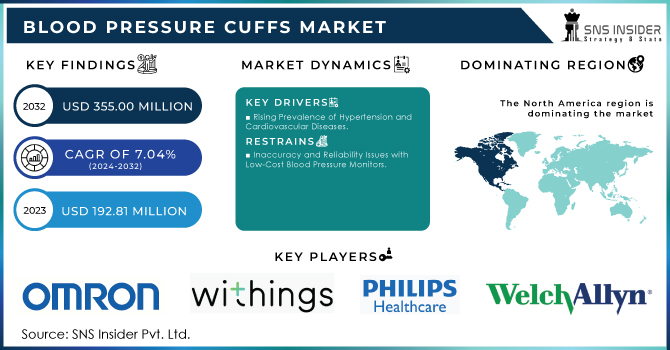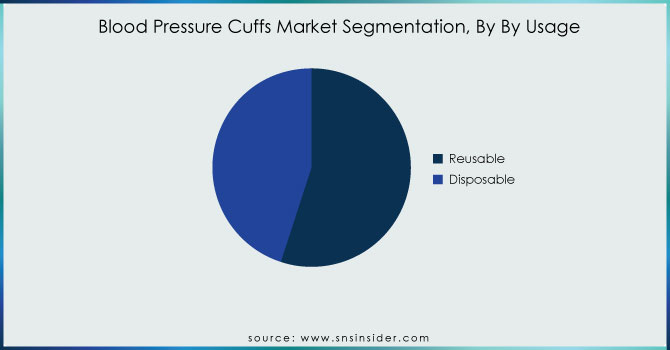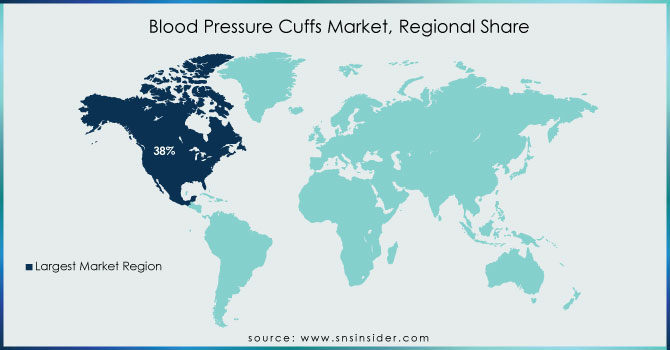Blood Pressure Cuffs Market Report Scope & Overview:

Get more information on Blood Pressure Cuffs Market - Request Free Sample Report
The Blood Pressure Cuffs Market Size was valued at USD 192.81 Million in 2023 and is expected to reach USD 355.00 Million by 2032 and grow at a CAGR of 7.04% over the forecast period 2024-2032.
The blood pressure cuffs market has experienced a notable expansion in recent years due to the rising occurrence of hypertension, an increasing elderly demographic, and enhanced awareness regarding cardiovascular well-being. Blood pressure cuffs, crucial medical instruments utilized for blood pressure assessment, are vital in the diagnosis and management of different health issues, especially high blood pressure. The market includes a variety of products such as manual, digital, and ambulatory blood pressure monitors, all tailored to meet various user requirements.
High blood pressure, also known as hypertension, is a primary factor in cardiovascular diseases, which rank among the top reasons for death globally. The World Health Organization (WHO) reports that around 1.89 billion adults between 30 and 79 years old suffer from hypertension, with most residing in low- and middle-income nations. The increasing prevalence has resulted in a rising need for blood pressure monitoring devices, for both medical and personal use. Blood pressure cuffs play a crucial role in these devices, ensuring precise measurements that are essential for diagnosing and managing hypertension effectively. Elderly individuals are at a higher risk for developing hypertension and associated health problems, which highlights the importance of consistent monitoring. Moreover, improvements in technology have resulted in the creation of more advanced blood pressure monitoring devices, such as digital cuffs which provide convenience, portability, and improved accuracy.
Market Dynamics
Drivers
-
Rising Prevalence of Hypertension and Cardiovascular Diseases.
The worldwide prevalence of high blood pressure is increasing rapidly, with millions of new diagnoses reported annually. This illness, also known as the silent killer, seldom shows signs in the beginning, causing a delay in diagnosis and treatment. Therefore, regular monitoring of blood pressure has become an essential part of preventive healthcare. Blood pressure cuffs are being more widely used in both medical facilities and homes as a key tool for monitoring. Changes in lifestyle, such as unhealthy eating patterns, sedentary behavior, and higher levels of stress, play a major role in the increasing number of hypertension diagnoses. The increasing number of elderly people is another important aspect, as they are more prone to developing high blood pressure. This population change is most noticeable in advanced nations, where healthcare systems are placing more emphasis on the management of chronic illnesses.
-
Technological Advancements in Blood Pressure Monitoring Devices.
Innovations in technology have transformed the market for blood pressure cuffs in the medical device industry. The shift from traditional manual blood pressure monitors to digital and automated ones has improved the accuracy, convenience, and accessibility of monitoring for a wider range of people. Blood pressure monitors with digital technology, including features such as spacious screens, memory capabilities, and error detection, are gaining popularity with customers. These devices make it easier to use as they eliminate the requirement for a stethoscope and manual inflation, particularly beneficial for the elderly and individuals with minimal medical understanding. The addition of Bluetooth and wireless connectivity has improved user experience by enabling the transfer of data to smartphones and health apps for improved tracking and management.
Restraints
-
Inaccuracy and Reliability Issues with Low-Cost Blood Pressure Monitors
The growing number of affordable blood pressure monitors has expanded the reach of these tools to a wider range of people. The affordability of these monitors frequently compromises their accuracy and reliability. Incorrect measurements may result in the improper handling of high blood pressure, posing potential risks for patients. Inexpensive monitors are frequently made using low-quality materials and technology, which may affect how well they work. Calibration problems, low-quality sensors, and erratic readings are frequent issues related to these gadgets. Incorrect readings can result in patients either overestimating or underestimating their blood pressure, which can lead to decisions about treatment that are not appropriate. The dependability of these gadgets is a worry as well, especially in isolated or rural regions where it may be difficult to reach healthcare professionals for verification or calibration. The extensive use of untrustworthy monitors may erode public trust in at-home blood pressure monitoring, leading to a negative effect on the market as a whole.
Market Segmentation Analysis
By Type
Automated cuffs led the market in 2023 with a major market share of 55% and are expected to grow at a faster CAGR during 2024-2032. Automated blood pressure cuffs are becoming more popular because they are simple to use, accurate, and can quickly provide readings without needing extensive training. These devices are frequently seen in household and medical environments, providing the benefit of minimizing mistakes made during manual readings. Incorporating advanced technologies like digital screens and automatic inflation and deflation systems improves user convenience and dependability. Moreover, the increased occurrence of high blood pressure and heart conditions, along with the growing popularity of self-tracking, has led to a higher need for automated blood pressure cuffs. Their fast acceptance is driven by their ability to work well with telemedicine platforms and electronic health records, making them the leading and quickest-growing segment in the market.
By Usage
Reusable cuffs dominated in 2023 with a market share of 55% because of their cost-effectiveness in the long run, particularly in medical facilities like hospitals and clinics that handle high patient volumes. These restraints are constructed from sturdy materials, enabling them to endure regular usage and cleaning, which makes them a popular option for healthcare facilities seeking to reduce continual expenses. They provide the benefit of being eco-friendly by minimizing medical waste, which supports the growing worldwide focus on sustainability in healthcare.

Get Customized Report as per your Business Requirement - Request For Customized Report
Disposable cuffs are to retain their rapid growth rate during 2024-2032 and become the fastest-growing segment. The growing focus on infection control and patient safety is fueling their need, especially in environments with a high risk of cross-contamination like ICUs and ORs. The COVID-19 outbreak hastened this pattern, emphasizing the significance of disposable medical tools in stopping infections from spreading. Healthcare providers find disposables convenient and increasingly affordable, which is attractive in areas with strict infection control rules.
By End User
Hospitals captured a major market share of more than 40% in 2023 and dominated the market. Hospitals always have the greatest need for blood pressure cuffs because they handle a large number of patients every day. These healthcare facilities need dependable, long-lasting, and precise blood pressure monitoring gadgets for different areas like ERs, ICUs, and wards. Hospitals are the main users of blood pressure cuffs due to the need for ongoing patient monitoring and strict healthcare regulations.
Medical centers are accounted for experiencing the most rapid growth in the Blood Pressure Cuffs Market during 2024-2032. The increase in clinics, especially in urban and semi-urban locations, is a major factor contributing to this expansion. Clinics are becoming a more popular choice for regular health check-ups and managing chronic illnesses because they are easily accessible and convenient. Due to the increasing focus on preventative healthcare, clinics are broadening their offerings to include routine blood pressure checks, resulting in a higher need for blood pressure cuffs.
Regional Analysis
North America led the market in 2023 with a market share of above 38%, because of its excellent healthcare system, high rate of hypertension, and growing focus on monitoring blood pressure. The area sees advantages from substantial healthcare technology investments and the presence of leading market players who continuously create more precise and user-friendly devices. The increasing elderly population, who are at a higher risk for hypertension, continues to drive the need for blood pressure cuffs. Furthermore, the growing prevalence of lifestyle-related illnesses like obesity and heart conditions adds to the rising demand for efficient blood pressure monitoring solutions.
Asia-Pacific is to experience a rapid growth rate during 2024-2032, due to the region's expanding healthcare industry and growing focus on health and well-being. The area is seeing a notable increase in economic growth, leading to better availability of healthcare services and medical equipment. Government efforts to enhance healthcare infrastructure and the increasing utilization of home healthcare options are further fueling market expansion. China, India, and Japan are leading the way in this growth, with growing investments in healthcare and international companies entering to capitalize on the huge opportunities in these developing markets.

Key Players
The major key players are Omron Healthcare, Withings, Philips Healthcare, A&D Medical, Welch Allyn, Beurer, Microlife, iHealth Labs, CardioCom, SunTech Medical, Spacelabs Healthcare, Draeger, Nisus Corp, GE Healthcare, and other key players.
Recent Development
-
February 2024, Omron Healthcare has developed the Complete Wireless Upper Arm Blood Pressure Monitor + EKG. The device is a blood pressure monitor that incorporates an electrocardiogram to determine the parameters of the human organism’s cardiovascular health. It is designed for more convenient use for the customers at home. The monitor can synchronize its data with a mobile device through Bluetooth.
-
June 2023, Withings has presented the BPM Core as part of the range of the blood pressure monitors. It is considered the most advanced among the range of the Withings devices. The monitor records ECG and operates as a digital stethoscope that can detect any valvular heart disease. The usage is aimed at more detailed self-control of the heart work of the customers at home.
| Report Attributes | Details |
|---|---|
| Market Size in 2023 | USD 192.81 Million |
| Market Size by 2032 | USD 355.00 Million |
| CAGR | CAGR of 7.04% From 2024 to 2032 |
| Base Year | 2023 |
| Forecast Period | 2024-2032 |
| Historical Data | 2020-2022 |
| Report Scope & Coverage | Market Size, Segments Analysis, Competitive Landscape, Regional Analysis, DROC & SWOT Analysis, Forecast Outlook |
| Key Segments | • By Type (Manual, Automated) • By Usage (Reusable, Disposable) • By End User (Hospitals, Clinics, Others) |
| Regional Analysis/Coverage | North America (US, Canada, Mexico), Europe (Eastern Europe [Poland, Romania, Hungary, Turkey, Rest of Eastern Europe] Western Europe [Germany, France, UK, Italy, Spain, Netherlands, Switzerland, Austria, Rest of Western Europe]), Asia Pacific (China, India, Japan, South Korea, Vietnam, Singapore, Australia, Rest of Asia Pacific), Middle East & Africa (Middle East [UAE, Egypt, Saudi Arabia, Qatar, Rest of Middle East], Africa [Nigeria, South Africa, Rest of Africa], Latin America (Brazil, Argentina, Colombia, Rest of Latin America) |
| Company Profiles | Omron Healthcare, Withings, Philips Healthcare, A&D Medical, Welch Allyn, Beurer, Microlife, iHealth Labs, CardioCom, SunTech Medical, Spacelabs Healthcare, Draeger, Nisus Corp, GE Healthcare |
| Key Drivers | • Rising Prevalence of Hypertension and Cardiovascular Diseases. • Technological Advancements in Blood Pressure Monitoring Devices. |
| RESTRAINTS | • Inaccuracy and Reliability Issues with Low-Cost Blood Pressure Monitors |

